7 Squadron Diaries - 1962 to 1974
| Recompiled from the 7 Squadron, Rhodesian Air Force, diary by
Eddy Norris, for the period 1962 to 1974, and for use on our
Rhodesian Heritage Blog. ORAFs understands that the history from
1975 to 1980 can be found in the book, "A Pride of Eagles." 1962
1. No. 7
Squadron was officially born on the 28th. February,
1962, with the promulgation of RRAF Orders, Issue No. 3
of that date, Squadron strength at that-time was 2
Pilots, Sqn, Ldr. Dowden, DFC, Commanding Officer arid
Flt. Lt Earp-Jones, who had completed a Helicopter
conversion course in France. The Squadron Technical
Officer was Fg. Off. Wood who had four technicians under
him - Snr. Tech. March and Cpl Techs. Atwill, Kelly and
Brown. Aircraft strength was nil.
2. However, 5 more Pilots, Flt. Lts. Taylor Nettleton and Cooke and Fg. Off's. Barnes and Piggot were undergoing a conversion course in the SAAF and were due to join the Squadron towards the end of May. A further 3 technicians, Chf. Tech. Harries, Cpl. Tech. Steele and and Cpl. Haddon were under training with Sud Aviation in France and were due back towards the end of March. The first aircraft were expected to arrive at the same time.
3. On the 27th March
at 1315 hours, a UAT DC 6 freighter arrived at New
Sarum carrying the first 3 Alouette Mk 111 aircraft
of the 5 ordered for the RRAF. The aircraft were in
a dismantled state, and assemble commenced on the
28th March, the first aircraft being completed at
1600 hours the following day. At approximately 1630
hours, Sqdn. Ldr. Dowden and Flt. Lt Earp-Jones
lifted 501 off the apron, the first flight of a
Helicopter in the RRAF. No. 7 Squadron was airborne
at last.
4, The second
aircraft was test flown on the 4th April and 2
days later Fg. Off. Piggott reported for duty.
Having previous experience on Helicopters, (and
plenty of it), his course with the virtually y
only been a type of conversion. On the same day
the 3rd aircraft was completed and flown.
5. Most of the
flying at this stage wis demonstrations for Police
and Army Units, and flying VIP's including the
Governor General of the Federation, Lord Dalhousie,
Large numbers of RRAF personnel were carried
during routine GF Training and by the end of the
first month 307 passengers were carried and a total
of 69,10 hours were flown between the 3 aircraft.6. The only operational equipment possessed by the Squadron was the cargo sling and strop and numerous sorties were flown both for training and demonstration purposes. All flying was confined to Southern Rhodesia during this period. 7. Politically inspired unrest in the African Townships of Highfield, Harare and Mufakose broke out during the night of the 13th/14th May, 1962 and at first light 2 aircraft were called out to assist Police Patrols of the townships. Of the 3 Pilots, one was attached to the Police control Ops. Room, while the other 2 carried out Recees, with Police observers on board. By the 16th of May all was quiet and the Squadron stood down. Helicopters are a success proclaimed the Press and No. 7 Squadrons first operational task was completed. 8. The remaining four Pilots had joined the Squadron by the 31st May, although Flt. Lt Taylor returned to the SAAF shortly afterwards to complete an instructor's coarse. He was appointed Flight Commander and Squadron QFI on completion of the course. 9. Work commenced in earnest on increasing the flexibility of the Squadron and discussions took place with the BSAP regarding LZs at all Police stations in Rhodesia, the carriage of Police Tracker dogs, fitment of Police radios to the aircraft and the possibility of dropping tear smoke from aircraft. The BSAP appeared to have taken a far greater interest in the possibilities of the aircraft than the Army at this phase of the Squadron's life. 10. The 13th of June saw the Squadron's first deployment out of Rhodesia when an aircraft was sent to Lusaka and Ndola for enplaning and deplaning drills and then positioning at Mkushi on the 15th where it was joined by a second aircraft for the Squadron's first participation in an Army Co-op exercise. On the 20th June one aircraft was sent to Nyasaland to participate in an exercise with the KAR. 11. By the 20th June, aircraft were flying to Police Stations in the Mashononaland area to photograph newly constructed LZs, taking down details such as fuel stocks, accommodation, medical facilities etc. which were then entered on an LZ indexed card. This practice continued until the squadron had complete data covering every official LZ, in the Country for easy reference by any Pilot being sent to any particular LZ. 12. Now that the Squadron had an instructor, continuation training and standardization flights were carried out. A training square had been marked out and whitewashed in Seki Reserve, soon to be followed by a second one. 13. During June, Police radios were fitted to the aircraft and trials carried out. At first, only one person in the aircraft could use the Police set which was independent of the normal radio and had only one mic/tel lead, This was later modified to feed into the normal intercom system and Pilots could listen out to both sets at once, although transmission still has to be selected to one or the other. More Police LZs were being built and photographed and LZs were to be cleared at Farms and Country Clubs throughout the Country which were used as Police Reserve Patrol bases. 14. Night flying trials were carried out to evolve the most satisfactory flare path, and numerous systems were tried out until the current standard 'T' of torches or flares 5 paces apart was agreed upon. The dimensions were passed to the Police and Army so that the Squadron is able to operate anywhere at night with the knowledge that the ground party will have laid down an acceptable flare path. 15. By July, the Squadron departed from SAAF training and decided to explore the feasibility of Instrument Flying. After experimentation, a canvas screen was fitted to obscure the right hand seat pilot's vision without obscuring that of the centre seat safety pilot. This proved sucessful and became standard practice. Pilots are now instrument rated on the Helicopter although actual IMC flying is not permitted as aircraft is not fitted with a standby instrument system. 16. The remaining 2 aircraft arrived on the 6th July and were soon assembled. The Squadron was now up to establishment. 17. Low level oblique photo recce waa an added role for the Squadron with the mounting of an F.24 electrically operated camera in the rear doorway. This a proved quite successful but was never used to any large extent. 18. In August, the Squadron carried out its first actual casevac when an injured mountain climber on an outward bound course was flown from the scene of his accident to Salisbury General Hospital by Sqn.Ldrr. Dowden. Over the ensuing years, the Squadron has lifted out hundreds of casualties ranging from serious illnesses in remote areas to battle casualties during counter insurgency operations. Casualty evacuation is considered as one of the most important roles and is an inestimable morale booster for troops engaged on active service. Squadron aircraft have landed in forward areas while fighting was in progress to uplift dead and wounded back to casualty clearing posts within minutes of their being hit. 19. Between July and September, 1962 many Arm and Police Co-op sorties were flown, and trooping drills practiced with both elements.. Police dogs were trained in emplaning and deplaning with their handlers. The Squadron flew in displays at Agricultural shows throughout the Country. 20. In September, nationalism reared its ugly head and on the the Squadron was put on readiness, one aircraft being despatched to Bulawayo. The following day the Prime Minister announced the banning of ZANU and the Squadron was operational again. Over the ensuing weeks, recces were flown over African townships and leaflets were dropped. 'Flag Waves' were carried out through African Reserves around Salisbury. During the period aircraft were detached for short spells at Chipinga, Gwelo and Enkeldoorn to assist Army and BSAP at local trouble spots. 21. In spite of 13 Operations in progress, routine training was carried out at base, and projects were put forward to increase the uses of the Helicopter for security force cooperation, the most important being the introduction of a rope descent system for deplaning troops in difficult terrain. However, this was shelved with the introduction of the hoist equipment. 22. When the Katanga crisis flared up at the end of December, an aircraft was sent to the NR Katangese border to assist the Army in border control and was followed two weeks later by a second. Both aircraft had returned to Salisbury by the 26th January, 1963 when it was considered that there was no further threat to the Federal border.
1963
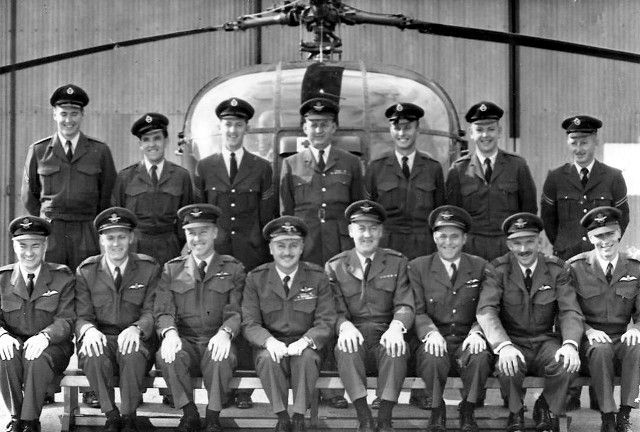 No. 7 Squadron, commanded by Sqn. Ld.r Dowden DFC – Aug
63
No. 7 Squadron, commanded by Sqn. Ld.r Dowden DFC – Aug
63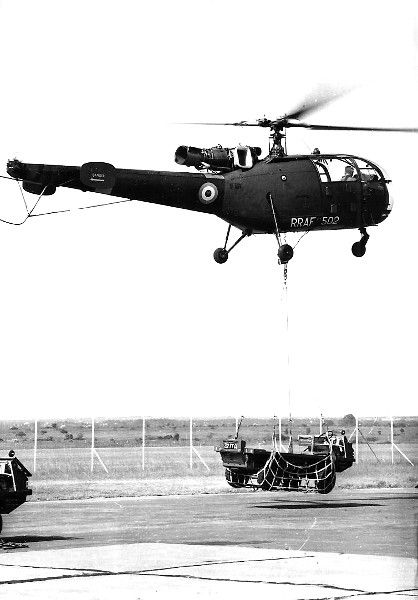 = =Cargo slinging a Steyr Puch FASOC vehicle – 8 Aug 63
23. Welcome news was given to the Squadron on the
17th January when it was announced that 3 further
Alouettes had been ordered for the RRAF. These were
due to arrive later in the year.
24. Exercise 'Brown 'Water', the last major Federal
Any exercise saw 3 aircraft back in Northern
Rhodesia from the 20th - 27th February to practice
anti-terrorist operations in wet weather.
25. March 1963 saw the first of the only 2 serious
accidents suffered by the Squadron, both of which
strangely enough happened to the same aircraft,
and in both cases the Squadron Warrant Officer was
aboard. In this case the aircraft apparently entered
the vortex ring state on an approach to a
playing field at Macheke and landed extremely
heavily, breaking its back. No one was injured.
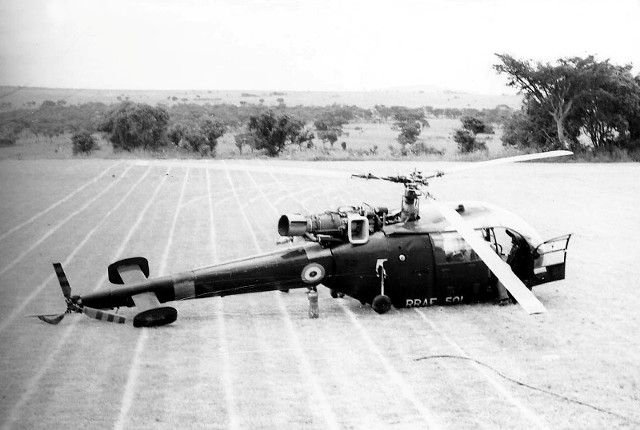 Alouette 501 (Flt Lt Taylor) – 21 Mar 63 26. 1963 was important far the unrest caused by the impending dissolution of the Federation. There was much speculation as to the future of the RRAF, and the possible dispersion of the forces to the 3 territories. When dissolution did occur, although a few of the technical personnel took advantage of the opportunity to exploit their Helicopter experience in the more lucrative civilian field, no aircrew showed any inclination to change their lot which speaks for the morale of a busy Squadron during an uncertain period. 27. In June, three aircraft were sent to Umtali to assist in the hunt for mass murderer Leopold Geoffrey Smith, returning 3 days later when Smith handed himself over to the Police. 28. The long awaited arrival of the additional aircraft occurred on August 6th. These were of a slightly improved modification standard main differences being all transparent front cabin, doors and a larger transparent lower centre panel in front, improving visibility. Hoist equipment was standard fit though subsequently all aircraft were modified to accept the hoist, giving the Squadron yet another role. 29. Squadron establishment was increased to ten Pilots with the arrival of Flt.Lt. Smithdorff and Fg. Off's. Hofmeyr and Becks in October 1963, having completed their helicopter conversion with the SAAF. Flt.Lt. Smithdorff was also appointed a QHI with Flt.Lt. Taylor. 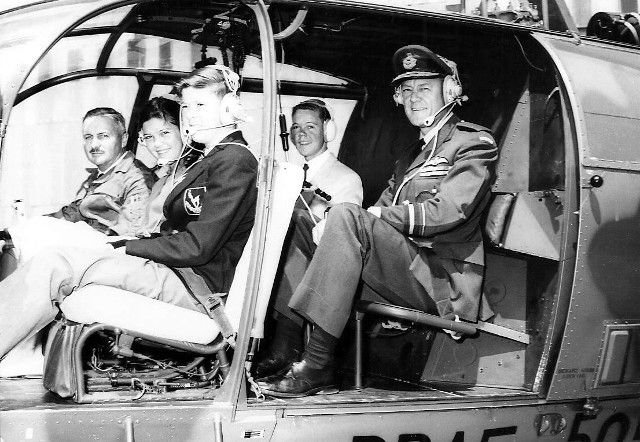 AVM Bentley and his family on an informal visit – 10 Sept 63
1964
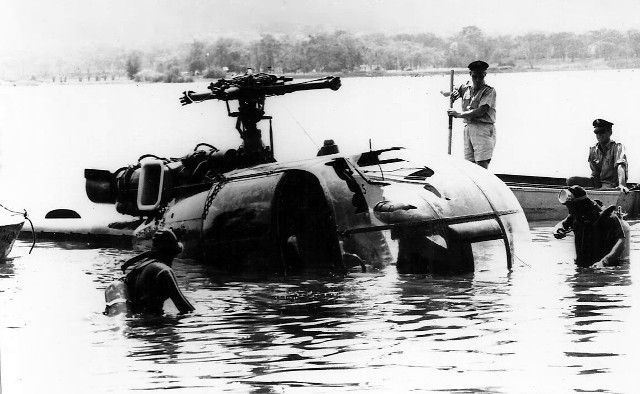 Alouette 501 in Lake MacIllwaine (Fg Off Becks)
Alouette 501 in Lake MacIllwaine (Fg Off Becks)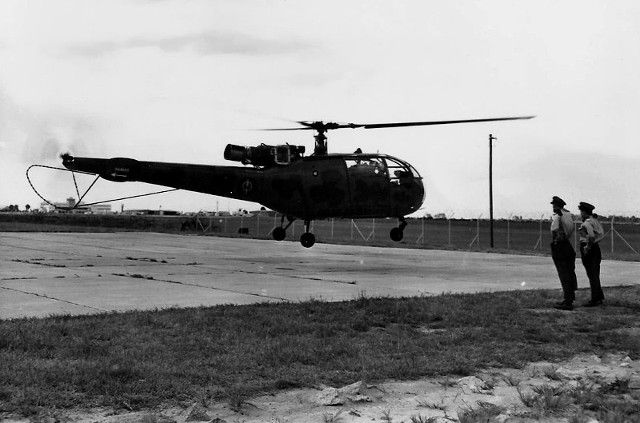 Alouette 501 on first flight after rebuild – 4 Feb 64  RLI deplaning at the hover – 24 Feb 64
30. Squadron Leader
O.D. Penton was appointed to succeed Squadron
Leader Dowden
with effect from 1st January, 1964. At 0001 hours
that day, during a magnificent New Years Eve Ball,
it was announced that Sqn. Ldr. Penton had been
awarded the AFC - a great day for the Squadron. He
left shortly afterwards for his conversion course
with the SAAF.
31.
In March it was announced that No. 7 Squadron
was to be affiliated to Fort Victoria and that
this would be effected at a civic ceremony on
the 6th June.
32. Sqdn. Ldr.
Penton returned from his SAAF conversion in
'March, the first Pilot
not to complete an Alouette 111 conversion. This
was accomplished locally by Flt.Lt. Smithdorff
and set a trend to be followed by later postings
to the Squadron, culminating in all through
conversions by the Squadron without previous
experience of the Alouette 11, which, though
pleasant, was not considered essential. At the
same time, the Squadron lost Flt. Lt. Earp-Jones
who was appointed Station Intelligence Officer.
33. In May, 4 VR Officers were posted to the
Squadron to assist as observers, forward area
Helicopter controllers and administrators. They
were never fully exploited and by 1967 their
services were withdrawn. Altogether, all
officers being redeployed in other sections of
the VR - lack of continuity, certainly not lack
of enthusiasm, probably being the major factor.
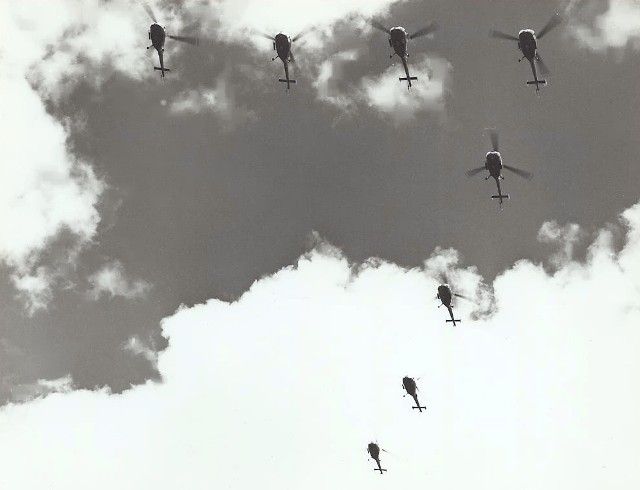 No. 7 Squadron formation in figure ‘7’ – 20 Mar 67 34. The much looked forward to affiliation with Fort Victoria took place as planned over the 6th/7th June and an extremely pleasant time was had by all. Social sporting activities were undertaken against the Citizens of Fort Victoria, and on the Sunday, following a Church parade, the Squadron spent a pleasant day at Lake Kyle. 35. Terrorism and anti-terrorist operations, first became part of the Squadron life with the murder of Mr. Petrus Oberholzer by a gang of Africans on the night of the 4th July, Initially, one Helicopter was called out to assist the BSAP investigation and was based at Nyanyadzi. Two days later, a further 3 Helicopters were sent to Nyanyadzi, supported by a forward air support operations centre (FASOC), Although on this operation the Helicopters had no success in catching the actual culprits, the use of the aircraft in bringing in large number of suspects and relatives of the wanted men for interrogation and also taking teams of detectives to kraals in remote areas proved invaluable in gathering a great deal of information very quickly. The aircraft were withdrawn from the operation on the 13th July. 36. HQ RRAF, in August, instructed the Squadron to carry out an evaluation programme into the feasibility of night hovering over water using both natural and artificial visual references, with a view to using either a rope or hoist descent onto a point, possibly a boat. 37. When the Minister of Law and Order announced the banning of a further 2 political parties, the People's Caretaker Council and the Zimbabwe African National Union, the Squadron was again called in to provide support to ground forces to prevent incidents of intimidation and violence in the townships. Operations were carried out from the 26th August to the 3rd September. 38. A milestone in the Squadron history was achieved on the 4th September when the Chief of .Air Staff, Air Vice Marshall Bentley, presented Sqn. Ldr. Penton with the Jacklin Trophy at a formal parade at RRAF, New Sarum. In his address, the Chief of Air Staff commented on the wide range of operational duties and exercises the Squadron had carried out with the Police and the Army, and commendable professional approach, coupled with considerable enthusiasm and imagination, with which their training had been coupled. 1965 39. During the first half of 1965, aircraft from the Squadron were called out on numerous occasions to assist the Police and Army in quelling politically inspired acts of violence in the rural areas and also were involved in operations aimed at the recapture of various political prisoners who had escaped from detention. 40. A further 2 Pilots joined the Squadron in June having completed an Alouette 11 conversion with the SAAF. Flt. Lt. Harvey and Fg. Off. Dixon had only flown 5 hours dual in the Alouette 111 and the rest of their conversion to type was to be carried out by the Squadron QHIs. This was to set a pattern for future Pilots who were to train with the SAAF and the culmination was that Pilots would not undergo any Alouette 11 training at all, the complete conversion to Helicopters and subsequent OCU being carried out entirely by the Squadron. 41. In October, the Squadron had the dubious honour of carrying the 2 African Nationalist Leaders, Mr. Joshua Nkomo of ZAPU and the Rev. Ndabaningi Sitholi of ZANU, to Government House where they were to confer with the British Prime Minister, Mr. Harold Wilson, during the ill fated Independence talks. 42. On the 9th November, aircraft detached to Gwelo, Kariba and Wankie. It was obvious at this stage that relations between Rhodesia and Britain were extremely strained and this move was to help prevent any possible outbreak of violence by extremists in these areas, Aircraft were in position when the Prime Minister, Mr. Ian Smith , announced the assumption of Rhodesian Independence on the 11th November, but despite the outcry overseas, there were no local incidents. 43. At this stage, it had been decided to fit the aircraft with some form of defencisive armament and the FN 7.62 mm MAG was chosen. This was fitted onto the port running board adjacent to the rear door. A reflector sight was fitted to the gun and the Squadron technicians were trained to operate the gun. After many representations to HQ RRAF, those technicians who qualified were issued with an Air Gunners Badge and became an asset in the times that were to come. 1966 44. In January 1966, a significant personnel changeover took place. Flt. Lt. Taylor was posted off the Squadron and was replaced by Flt. Lt. Petter-Bowyer, also an instructor. Sqn. Ldr. Rogers came to the Squadron sa a supemumary officer, prior to joining officially in February, when he was to to take over command from Sqn. Ldr. Penton who was promoted and appointed Officer Commanding Flying Wing at New Sarum. The 2 new Officers were the first to be wholly trained by the Squadron.
45. Flt. Lt. Piggot, another founder member
of the Squadron, was posted off the Squadron
in March and was replaced by Flt. Lt.
Barnes, another founder member who had
completed a ground tour at H.Q. RRAF.
46. 1966 now took an ugly turn, and a trend set in which was to last well into the future. A heavily armed gang of 7 terrorists had infiltrated into Rhodesia, and had penetrated as far as Sinoia. On the 27th April, one aircraft had been called out to assist in rounding up the gang whose presence had been betrayed by an informer. Two days later, when the position of the terrorists had been established, a further 3 aircraft were called out, one of which was armed with the MAG. 47. When they were flushed, the gang resisted heavily, and a running battle ensued during which all 7 were killed, one being killed by fire from the Helicopter. There were no casualties to Security forces and everybody hoped that any future incursions could be dealt with as quickly and effectively. This was not to be the case. 48. On the night of the 17th May, a European farmer and his wife were shot to death in the doorway of their isolated farm house near Hartley and the discovery of their bodies sparked off the biggest manhunt in Rhodesia. 49. Aircraft from the Squadron were soon at the scene and assisted the Army and Police throughout the operation which ranged from the Hartley area to Kanyemba until the last member of the gang, also of 7, was arrested near Mtoko early in November. 50. The operation was further complicated by the deployment of additional forces to the Karoi area where three Europeans had been found murdered on their farm. This, however, proved to be a domestic murder and an African servant was arrested. Also, while the operation was progressing in the Kanyemba area, two gangs of terrorists crossed the Zambesi in that area but became lost and ventured into Portuguese territory where a number were caught by locals and handed over to the authorities. 7 Squadron operated freely into Portuguese territory carrying our own Army and Police and also elements of the Portuguese Army who assisted in rounding up the remainder of the gangs. 51. Infiltration of groups of terrorists continued until almost the end of the year, with numbers of up to 12 in each group. entering the country at various points around the border ranging from Mambali in the Kezi District, Binga, Chirundu and as far north as Kanyemba. One particular group penetrated as far inland as Nkai where their murder of a local Headman was the first indication of their presence. In all cases. Helicopters were used to assist ground forces in the capture of terrorists and the recovery of arms and ammunition. 52. During 1966, a further 2 Pilots were converted to Helicopters wholly by the Squadron, Fg. Off's. McLean and Slatter. A further Pilot, Flt.Lt. Nicholls was partially trained here, having completed the Alouette 11 course with the SAAF. However, the Squadron lost another founder member, Flt. Lt. Cooke and an early member, Fg, Off. Becks to other duties. 53. At the end of the year, all terrorist activity appeared to have ceased and the Squadron was able to concentrate on routine training, and on further projects to increase flexibility as a result of lessons learnt during operations. All technicians received further training on the MAG and classified as Air Gunners, some very good scores being achieved on the range. 1967
54. A
signigicant development in the
operational equipment of the Squadron with
the fitting of a self contained pressure
refuelling system devised by Flt.Lt. Petter-Bowyer,
operating on pressure drawn from the
engine. A drum of fuel could be emptied
into the fuel tank in approximately 5
minutes as against the 20 minutes
required when using a hand pump,
obviously an asset in the heat of
operation.
55.
Another Pilot, Flt. Lt. Grier, joined
the Squadron in Mayy having completed
an Alouette 11 course with the SAAF and
commenced his conversion to the Alouette
111 just in time for the 'season' to
start.
56. In
June aircraft were again called out on
anti-terrorist operations in the Chirundu
- Makuti area. These continued to follow
the pattern of previous operations until
August when things took a change for the
worse, What started as a
normal operation in the Wankie area soon
assumed alarming proportions when it
was realised that up to 100 terrorists
were involved, including members of the
South African "African National
Congress".
57. This
operation, which lasted until September,
saw the Helicopters, aided by
Helicopters of the South African Police
from Katima Mulilo extremely
busy providing top cover, flying in
ammunition and supplies and carrying out
dead and wounded from Wankie to point
222 on the Botswana border, A number
of terrorist killed during the operation
were attributed to Helicopter fire.
58.
During this period, Fit. Lt. Sinithdorff
was posted as OC the training squadron
at Thornhill. Fg. Off. Slater became
qualified as an instructor, his training
combining with that of Fg. Off. Jones,
who was also wholly converted by the
Squadron.
59. By
the time 1967 ended, the Squadron wag
committed to maintaining aircraft
semi-permanently based. at Wankie and
Kariba on border control duties. Sqn.
Ldr. Rogers, having commanded the
Squadron for a hectic but satisfying two
years, was posted to command No, 5
Squadron, and Sqn. Ldr. N .Walsh
commenced what promised to be an equally
interesting tour as Officer Commanding.
1968
60, During the first ten days of January, a further two groups of terrorists were mopped up, one near Katima and the other near Makuti. It is probable that the propositioning of aircraft at forward areas contributed to the speedy conclusion of these operations.
61.
The Squadron underwent a fairly
quiet period, notable mainly for the
new Squadron
Commander completing his conversion
and the award of the Jacklin Trophy
for the second time. Another Pilot,
Pilot Officer Thomas, was sent
to South Africa for an Alouette 11
conversion prior to joining the
Squadron in May. However, the fact
that border control is not
infallible was severely brought home
in April when our forces, following
up tracks discovered by a Game
Ranger on the Angwa River at the
base of the Zambesi
escarpment, encountered a large
group of terrorists in a base camp
that was extremely well organised.
Helicopters assisted in giving top
cover to the ground forces
and marked the position of the base
camp with white phosphorous smoke
when Vampires were called in for an
air strike.
62.
It soon became obvious that this had
been an extremely well organised infiltration
and Squadron members flew many hours
assisting in the location of other
base camps and in the rounding up of
the groups of terrorists who had
scattered in all directions
following the air strike. Wounded
and dead of both sides were flown to
casualty clearing posts and a vast
amount of
terrorist arms, ammunition and
equipment was flown out from base
camps captured by Security Forces,
Again, a number of dead and wounded
terrorists were attributed to fire
from the Helicopters. The operation
was terminated towards the end of
May and the Helicopters reverted to
border control duties.
63.
From the first of the large scale
operations in August, 1967, No. 7 Squadron
had been assisted by Helicopters and
crews of the SAP who continued to
assist us on border control duties
on a rotational basis. This had the
effect of releasing 7 Sqn. crews
from the border areas for essential
routine training and administration
duties back at base.
64.
The termination of operation
"Cauldron" was not destined to be
the end of terrorist
activities for 1968. Although June
was relatively quiet,
enabling Squadron training to be
concentrated on, July saw the
Squadron involved in three more
operations within Rhodesia;
Operations "Griffon" localised in
the Kariba area, "Mansion" confined
mainly on the Gwaai/Zambezi
confluence and "Excess" in the
Kanyemba area. All three operations,
although relatively short in
duration, were hotly contested by
the terrorists. However, with
the security forces still at a high
peak following "Cauldron", the
terrorists stood no chance at all.
"Griffon" and "Mansion" were
destined to become "classic" operationsstill
used as examples for
counter-insurgency training. Two
years later, many members of the
Squadron were to receive swards for
their efforts during 1967 and 1963,
with Squadron Leader Walsh receiving
the Bronze Cross of Rhodesia for
action in operation ""Griffon" and
Flying Officer McLean the same
decoration for his part in the
opening stages of operation
"Cauldron".
65.
Notwithstanding the fairly frenzied
activity within Rhodesia, the
Squadron also
provided four aircraft for an
operation code named "Tripper*
which provided airborne support for
a neighbouring territory not yet
equipped with Helicopters against
terrorists. This type of operation
was to continue until early 1971
when the territory concerned became
self-sufficient in helicopters.
66.
Two new Pilots, Flt. Lt. Du Rand and
Fg, Off, Roberts were posted onto
the Squadron
in August, 1968, With the exception
of four further external operations,
each of a weeks' duration and
employing four crews, 1968 drew to a
quiet conclusion. Not until 1973 was
the Squadron to see such frenzied activity
as had been experienced in the first
half of 1968.
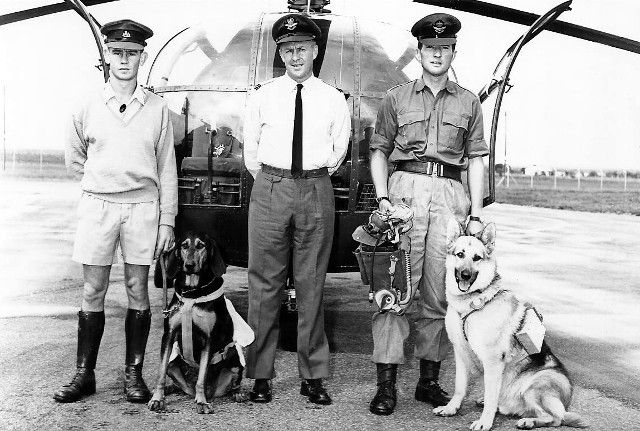
‘Electric’ Dog Trials with Flt Lt
Petter-Bowyer – 28 Nov 68
1969 67. January, 1969 saw the first fully experienced helicopter pilot from another Air Force join the Squadron. Flying Officer Briscoe, who had operated, with the Squadron as an S.A.P. Pilot during operations "Nickel" and "Mansion" joined the RRAF. and was immediately posted to the Squadron. In March, Flying Officers Griffiths and Hill joined the squadron to replace Flight Lieutenants Hofmeyr and Barnes who were posted to Headquarters and 6 Squadron respectively. Both Pilots had been on the Squadron since shortly after its inception and were extremely experienced. The establishment of the Squadron had now been raised to 14 Pilots.
68.
April saw the promotion of Sqn. Ldr.
Walsh to Wing Commander and his posting
to O.C.Flying Wing at New Sarum. The
Squadron was extremely sorry to see
him leave after what was probably
the most rewarding tour of
any Squadron Commander, but could
only agree that his new post would
benefit all the Squadrons on the
Station. At the same time, one of
the squadron's first fledglings
came home to roost - Squadron
Leader Nettleton one of the
original Pilots
was appointed to be the new Squadron
Commander.
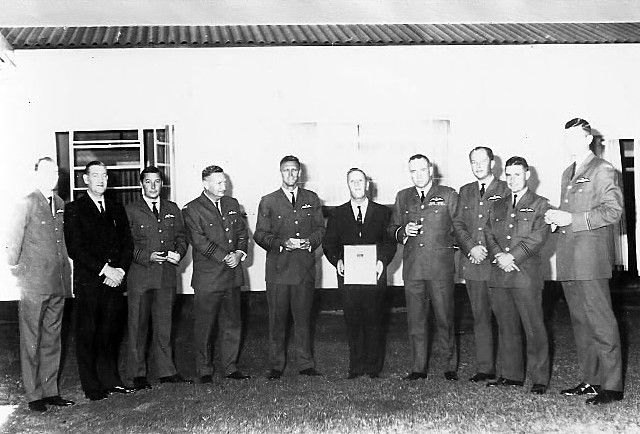 Presentation of ‘1000 Hour’ tie pins – 14 Nov 69
69.
In November 1969, another milestone
in the Squadron's history was passed
when Henry Ford, of Rhotair on
behalf of Sud Aviation presented
1,000 hour diamond tie pins to Sqdn.
Ldr. Nettleton and Flt. Lt's.
Barnes, Briscoe, Harvey, Hofmeyr and
Smithdorff and was in turn presented
with a Squadron crest in
appreciation of toe support he has
given the Squadron since it
was formed.
70.
Fg. Officers Meikle and Penton
joined the Squadron at the beginning
of November
and immediately commenced training.
They were destined to replace Flt.
Lt's. Dixon and Harvey who had been
notified of their postings to No's.
2 and 4 Squadrons respectively.
Apart from a number of
external operations and routine
exercises, 1969 proved to be an
uneventful year, but the situation
was to change rapidly in the new
year
1970
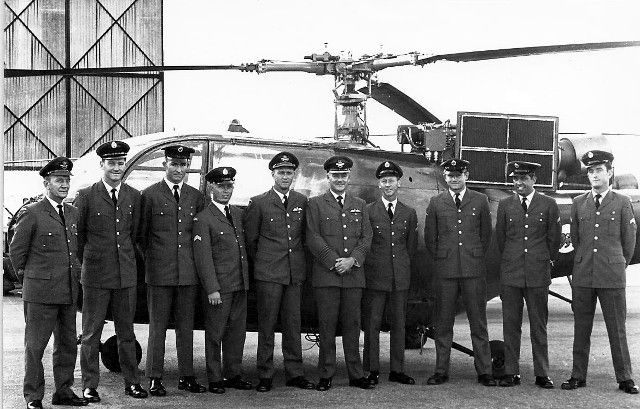 Presentation of Air Gunners’ Badges – 30 Apr 70 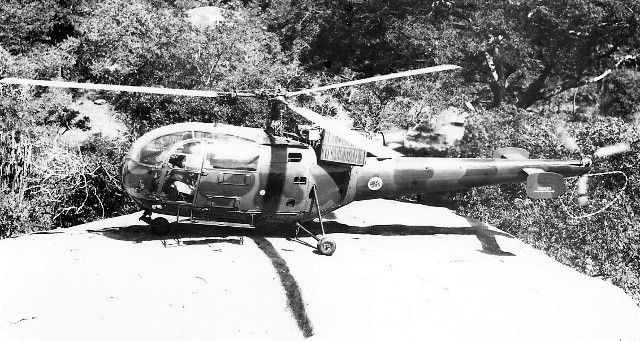 Alouette III LZ practice – 22 Apr 70 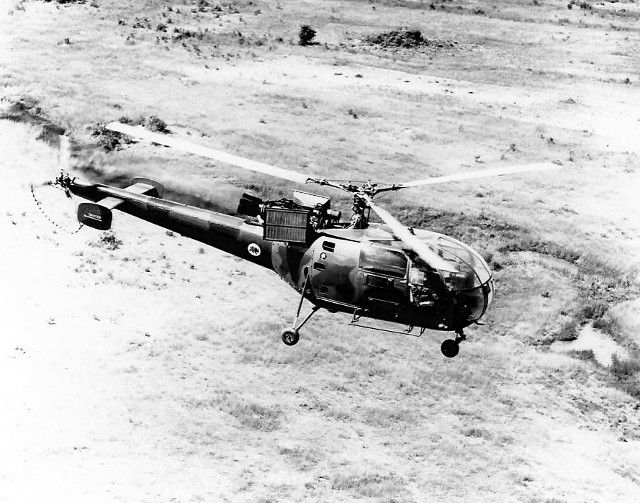 Air to air of Alouette III – 22 Apr 70 71. On the 2nd January, two aircraft wore called out to support security forces in the Wankie area on what was to become known as Operation "Teak". This was followed later in the month by another infiltration in the Kanyemba area which led to Operation "Birch". At first these operations, followed by abortive hit and run raids on Kariba and Victoria Falls airports and the capture of terrorists in the Matopos, gave the impression of 1968 starting all over again on a much wider front. This, however, proved not to be the case and in fact turned out to be the last serious attempt at infiltration by ZAPU up to the time of writing. The Squadron was involved in all the operations and on Operation "Birch", during one follow up, actually dropped troops so close to the enemy that contact was made almost before the aircraft engine noise was out of hearing. Luck was still with us. On subsequent operations one aircraft landed so close to the enemy that one terrorist, after his capture, was able to describe the Pilot and Technician to the extent of being able to read what was written on the back of the Technicians bone dome - aptly enough, the inscription read simply "I'm Mad!
72 In March a further two
Pilots, Fg.Officers Cook and
Phillips joined the Squadron
for their conversions. The
Squadron was also involved in a
typically unusual task, this
time for the Post Office, in
establishing the
necessary height of two towers
for the micro-wave link between
Salisbury and Umtali. This was
achieved with the aid of
flashing mirrors, the aircraft
descending in the hover over the
respective sites until visual
contact with the mirror was
lost. A cord suspended from the
aircraft to the ground was then
out at the right height.
73. May and Juno saw the posting
off of Flt. Lt. Slatter and the
posting on of Air
Lt. Wrigley respectively, both,
postings to and from No. 6
Squadron.
74. On the first of July,
Squadron Leader Nettleton and
Flight Lieutenant Hill
were killed in the Squadron's
first fatal accident. The
Accident, which occurred as they
were approaching to land after
an I.F. Sortie, remained
unexplained despite exhaustive
enquiries involving M. Coffignot
and M. Brunelin of Sud Aviation,
With the death of Sqn. Ldr.
Nettleton, the Squadron lost one
of its most dedicated Officers,
and with that of Fit. Lt. Hill,
one of its most cheerful.
75.
Following the death of Sqn. Ldr.
Nettleton, Sqn. Ldr. Grier, another
former squadron
member was appointed to command the
Squadron. Only a short refaml
and O.C.U. was required to bring the
boss back to operational status.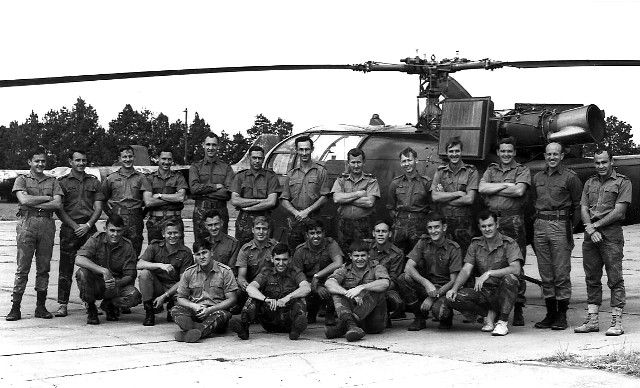 No. 7 Squadron commanded by Sqn Ldr Grier – 5 Aug 70
76. In August, the new permanent
army border control base was
completed on the
top of Rushinga Hill. The
Squadron was how committed to
one aircraft permanently based
at Kanyemba and Rushinga on
border control duties, with SAP
aircraft normally manning FAF 1
and FAF 2. Crews were
normally changed over on a
weekly basis by Trojan and
Dakota on the shuttle and weekly
Mt. Darwin meeting runs.
77. The Squadron was able to
lend a hand to our sister 1.S.
Squadron during September
when two aircraft, returning
from night flying practice,
were diverted to the Sinoia area
following a Mayday call from Air
Lt. Baynham who was flying to
Salisbury from Kariba with an
injured Game Ranger aboard
when his engine failed, The
helicopters were on the scene
very shortly after the Trojan's
extremely lucky forced landing
in the dark during which no
injuries were sustained and
conveyed the Trojan crew and
casualty to Salisbury, This feat
was repeated the following month
when another Trojan, this
time during the day experienced
a similar engine failure, also
from Kariba and again with a
casualty aboard, although this
time only one aircraft was used.
78. During November, the first
protracted external operation
involving the Squadron
commenced with four aircraft
being based at Chicoa on
the Zambezi, This operation was
to continue until February, 1971
when all aircraft were
withdrawn.
1971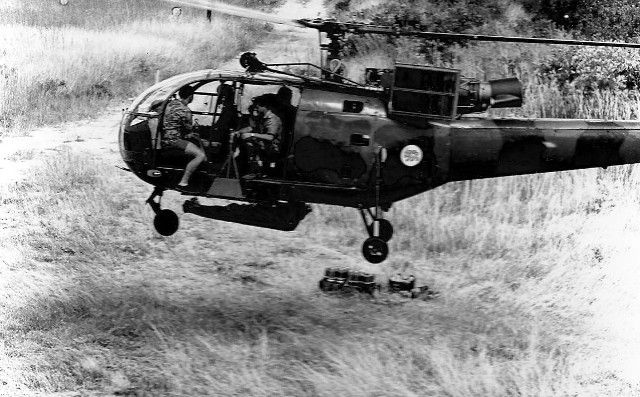 No. 7 Squadron Detachment to Kutanga Range – 1 Mar 71 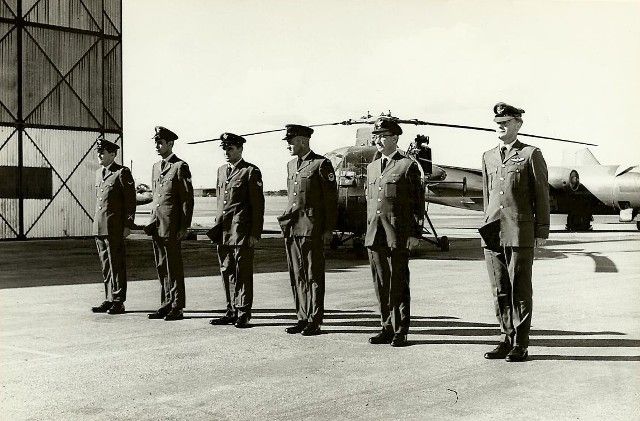 No. 7 Squadron Air Gunners – 10 Mar 71 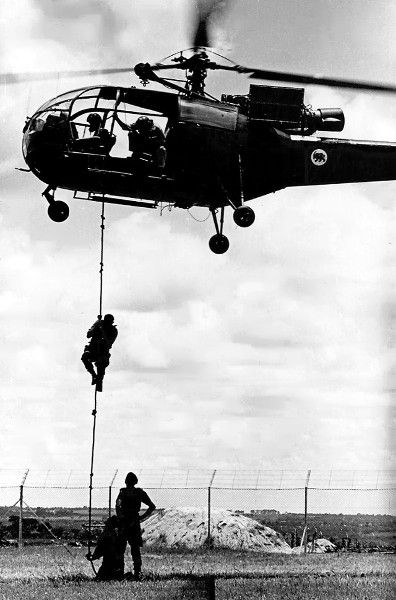 RLI trooping and rope descent – 23 Mar 71 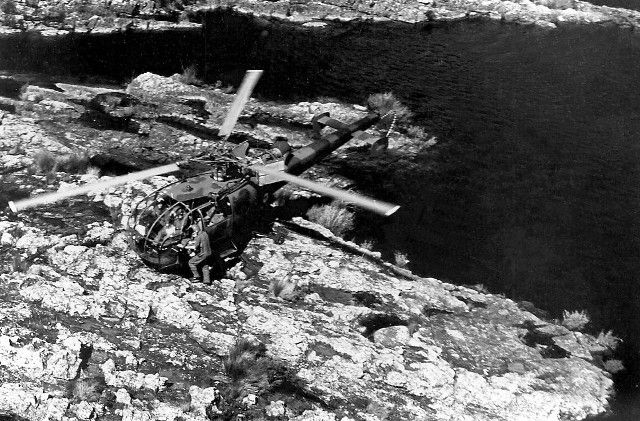 Trout stocking in the Chimanimani mountains – 25 Mar 71
79. During January, an accident
resulting in Cat. 4 damage to
one of the aircraft
occurred at Chicoa. A
contributory factor to the
incident was considered to be
the lack of academic practice on
the part of the pilot concerned,
and in fact for the Squadron as
a whole, and in mid February
all aircraft were withdrawn to
base for a period of
consolidation flying.
80, At the beginning of the
year, Flt,Lt.'s Smit, Cronshaw
and Air Lt. Law joined
the squadron for conversions,
the Squadron losing three long
standing members in Flt.Lt,
Nicholls and Air Lt.'s Thomas
and Briscoe shortly afterwards.
Flt, Lt, Harvey was attached to
the Squadron in February to
help relieve the workload
incurred on operations and this
attachment became a posting some
weeks later. Unfortunately, Flt.
Lt. Smit's O.C.U.
was unsuccessful and he was
posted to 3 Squadron.
81, The Squadron
establishment was again
increased and four more
Pilots, Air Lt.'s
Munton-Jackson, Paintin,
Baynham and Watt duly
arrived for
conversion. Another
unsuccessful O.C.U. occurred
in the case of Air Lt.
Paintin who also left
to join 3 Squadron.
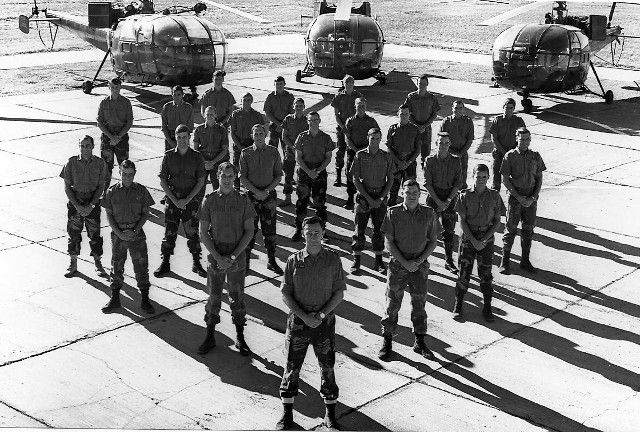 No. 7 Squadron commanded by Sqn. Ldr. Grier – 8 Jun 71
82. Generally, the year was
a quiet one, notable
exceptions being a, short operation
in the Mukumbura area
following an incident in
which an RLI vehicle struck
a land mine just across the
river, where the Rushinga Helicopter
carried out the initial
casevac On the next day a
follow-up operation was
commenced resulting in a
large base being located
and a short, sharp contact
at last light, This
operation was then handed
over to Portuguese Forces
and our own units withdrawn.
83. The second operation
took place in the Rushinga
area during August/September
when it became evident that
a Frelimo group had
entered Rhodesia on a
punitive raid. Four aircraft
were initially deployed on
the operation, reducing to
three after the first week
until the operation
was terminated on the 9th
September.
84. Normal border control
operations continued
throughout the year with aircraft
being deployed periodically
to Kariba and Kanyemba and,
from the onset of the rains,
to Binga, A number of
routine Army co-operation
exercises were held and
during one of these an RLI
recruit fell from an
aircraft in flight and was
killed. This incident was
later presumed to be
suicide. It was also during
this year that rope descents
were re-introduced as
hoisting was considered too
slow in operational areas.
However, this did not prove
over successful when a few
soldiers were injured
falling off the rope, and
rope descents were
restricted to regular
soldiers only.
85. In April, an experienced
Helicopter Instructor from
the Royal Air Force, Air Lt.
Annan, joined the force and
was posted to the Squadron,
and in November Air Lt.
Roberts rejoined the
Squadron having left in
February for a spell
as Station Adjutant, Air Lt.
Cook was posted off to fill
that position.
86. Social highlight of the
year was the annual
affiliation visit to Fort
Victoria in
June during which all
members of the Squadron
participated in
either Hockey or Soccer
matches against the local
Ladies and gentlemen,
followed by a Mayoral
reception and informal
dance, During the year, the
Squadron Pilots were hosts
to Officers of the 1st
Battalion Rhodesia Regiment,
the Rhodesia Light Infantry,
Artillery and Special Air
Services at a social
get-together in the Officers
Mess, New Sarum.
87. The Squadron undertook
to defeat a team from No. 2
Commando RLI at Rugby
in August, but were
unsuccessful in their
endeavours. The after
match festivities
unfortunately had to be
cancelled as the Commando
were involved in rehearsals
for the Salisbury Show.
1972
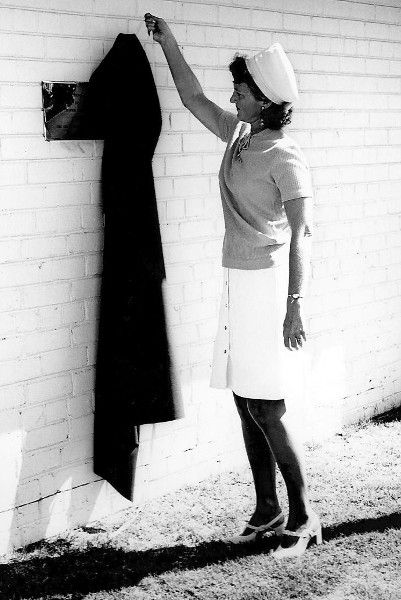 Mrs. Gordon Nettleton unveiling the plaque at the swimming pool – 3 May 72 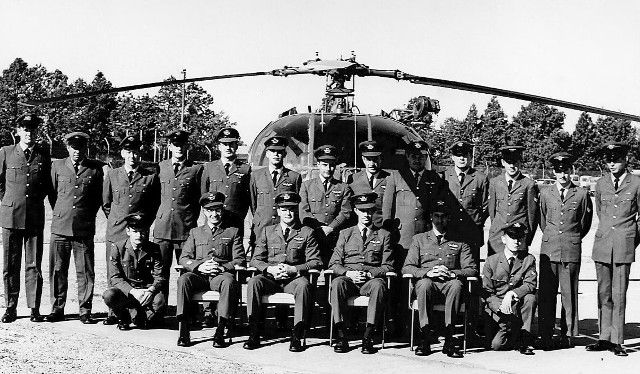 No. 7 Squadron commanded by Sqn Ldr Grier – 20 Jun 72
88, On the 14th January,
1972, aircraft were deployed
to Bulawayo, Gwelo and
later Umtali to assist the
Police in quelling African
unrest associated with the
presence of the Pearce
Commission. While on a
positioning flight from
New Sarum to Shabani on a
similar task, Air Lt. G.
Munton-Jackson and Flight
Sgt. P Garden crashed and
were killed.
89. At New Sarum, in
addition to the normal 1
hour standby aircraft, two further
aircraft fitted with tear
smoke dispensers were on
standby, the readiness state
for these aircraft was
varied between 15 minutes
and one hour dependent on
the situation in the city.
Although various recces of
African Townships were
carried out during the
period of unrest, extremely
poor weather conditions kept
the aircraft on the ground
for most of the time.
All Aircraft were recovered
to base early in February.
90. A number of
operations were carried
out during the year in
support of ground
forces, the first
notable one being the
activation of Nyamasoto
Airfield in the North
Eastern Border area,
similar to the operation
in the Rushinga area
during the previous
year. Four aircraft were
deployed for the
duration of this
operation in support
initially of the SAS and
then the RLI. It was
of particular value in
that relatively new
crews were able to
acquire
operational experience
in the company and under
the guidance of more
experienced crews, During one
of the contacts an this
operation a helicopter
technician was injured
by fire from a
terrorist.
91, During the year,
Flt, Lt. Woolcock and
Air Lt.'s Paxton and
Porter were posted
to the Squadron, which
also gained another ex
Royal Air
Force Helicopter Pilot,
Air Lt, Smart, who had
also seen service with
the Sultan of Oman's Air
Force.
92. On the Social aide,
the Squadron was able to
visit Fort Victoria
again during
the year, being
accommodated in private
houses for a
pleasant weekend of
friendly sports matches
culminating in a
Braaivleis. Also of
note was that at the end
of the year, the
Squadron having been
charged with the running
of the Officers' Mess
Xmas Draw, succeeded in
raising the largest sum
of money towards prizes
that the Mess has known.
93. Routine training
throughout the year
included an operational
shoot held in
the Kariba area, also a
Squadron competition was
instituted to be held
on an annual basis. The
competition tests the
skills of Pilot and
Tech. as a crew, and a
trophy was donated to
the Squadron by Mr.
Holland of Cocoa Cola to
be presented to the
winning crew.
94. This year was the
Squadron's turn to
present a symposium to
the force, and
the subject chosen was
Counter Insurgency. A
lot of effort was put
into the symposium by
teams working in
rotation on return from
operations, and the
general consensus of
opinion was that the
symposium was
highly successful (as a
result of "special
effects", the audiences
were guaranteed not to
nod off during the
presentation).
95. In September, the
Squadron at last moved
into modern
accommodation built into
the side of the hangar,
having literally lived
in boxes for most of
its existence.
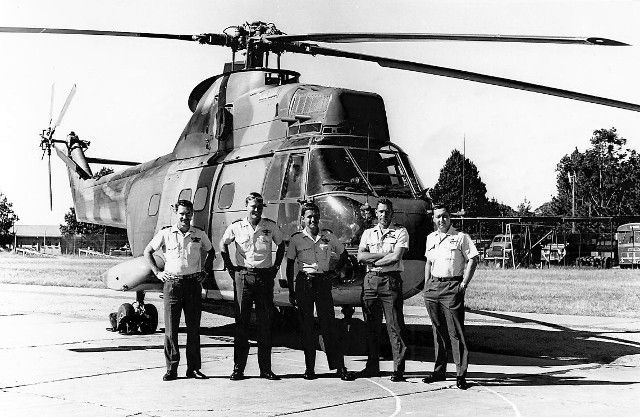 No. 8 Squadron members in front of SAAF Puma 1973
96, Flt, Lt, Woolcock
and Air Lt, Penton were
selected to attend a
Coin course held
at the School of
Infantry during
November; and reported
the course to have been
of good value to members
of this Squadron.
97. Towards the end of
the year, terrorist
activity became apparent
in the Mtoko
area and one aircraft
was deployed to support
operations there.
This particular
operation terminated
fairly quickly and not
exactly satisfactorily
when it was concluded
that the terrorists had
returned to Mocambique. However,
although it was not
known at the time,
events were being
noticed in the North
East following this
operation that were to
have far
reaching consequences.
98. Four days before
Xmas, a European Farm
was attacked in the
Centenary area,
followed by a second
attack on a nearby farm
two days later. By
New Years' Eve, five
aircraft had been
deployed to Centenary on
what had become named
Operation "Hurricane" ,
This was to become by
far the most serious
and Widespread operation
in Rhodesia and it soon
became obvious that
nearly the entire North
Eastern sector of the
country had been
subverted by ZANU terrorists.
Very few Squadron
personnel were at home
over the festive
season, and as the New
Year commenced, it
became apparent that the
situation was not likely
to improve for some time
to come.
1973
99. By early January it
was obvious that the
situation on the North
Eastern Border
was extremely serious
and the Squadron was
heavily committed to
the operation. The
Squadron's position was
even further taxed by
sporadic landmine
incidents in the
Victoria Falls area.
100. At the beginning of
January, Sqn. Ldr. Grier
was posted to a Staff
Course and
was succeeded by Sqn.
Ldr. E.R. Wilkinson, who
was posted in
together with Air Lts.'
McGregor, Caldwell and
Rowe. To ease the
situation, all
these pilots were sent
to the Helicopter
Conversion Unit at
Ysterplaat for their
basic flying course, and
five previous members of
the Squadron were
brought back strength.
Sqn. Ldr. du Rand acted
as Squadron Commander
during Sqn.
Ldr. Wilkinson's absence
and with Flt. Lt.'s
Dixon, McLean, Thomas
and Briscoe no time was
lost in carrying out a
quick familiarisation and
deployment on the
operation.
101. During February, while operating out of Rushinga on the Operation, Air Lt. Smart and Sgt. Smithdorff were killed when their Aircraft crashed just east of Gungwa on the North Eastern Border. After an extensive air and ground search which lasted five days the wreckage was discovered by a Police Reserve Air Wing Aircraft.
102. By March,
terrorist activity
saw squadron
aircraft deployed as
far afield as Karoi
and Wedza, as well
as what had now
became our normal
contribution
to operation
"Hurricane". The two
above mentioned
sections were
perpetrated by Frolizi
infiltrators which
for the first time
included coloureds.
It is noted
that these two
groups were quickly
accounted for and to
all intends and
purposes this has
spelt the end of
Frolizi as an
effective
organisation.
103. The Squadron's
"Happy Wanderers"
returned from South
Africa and commenced
their advanced
flying and
operational
conversion in mid
April. They had been
joined down South by
Flt. Lt. Wrigley who
completed a
short course on the
Alouette 11. All the
new pilots were
operational by early
June, by which time
the attached pilots
who had designated
themselves
"8 Squadron" had all
returned to their
units.
104. The acquisition
by the Squadron of
another qualified
helicopter pilot in June
brought our strength
up to 18. Air Lt.
Thorn, who joined us
from Kenair, the
Rhodesian Commercial
Helicopter firm,
although a Rhodesian
himself
had originally
trained with the
Royal Navy and
brought with him
some
valuable experience.
After Alouette
conversion and O.C
transparent.. he was
operational
in August.
105. Six SAP
helicopters with
their crews were
added to the
Helicopter effort in
July, but the scope
of the Operation by
now was such that
this had no effect
in alleviating the
Squadron commitment
at all; and in fact
our own effort was
spread further
afield to
accommodate
operations across
the border. The SAP
aircraft remained in
the field based at
Mount Darwin and
Centenary until the
end of the year and
have been very such
part of the
operation.
106. An informal
Parade was held at
the Squadron in
August, when 10 new Air
Gunners were
presented with their
badges by D.G.S.S.
In his address, D.G.S.S.
announced the
impending arrival on
the Squadron of 20
mm armed "Gunships".
He also told of the
possibility of
Gunners in future
undergoing
full courses to
qualify as brevetted
Flight Engineers, A
prospect greeted
with
much enthusiasm,
following the Parade
a celebration was
held in the Sports
Club at which Mr,
Henry Ford presented
1000 hour tie pins
to Flt.Lt.'s
Wrigley, Roberts,
Phillips and Annan
and Air Lt, Penton.
Another squadron
milestone was passed
at the same time
when Flt. Lt. Harvey
received his 2000
hour tie pin from M.
Ford.
107. Four members of
the Squadron were
able to motor to
Fort Victoria to attend
the inauguration of
the new Mayor of the
town during the same
month. Operation
commitments
precluded the use of
aircraft for this
occasion, and
in fact apart from a
monthly newsletter
sent by the
Squadron, Fort
Victoria has had
little contact with
us during the year.
However, the Lions
Club of
Fort Victoria sent
the Squadron a
cheque for $50.00
which we divided
between the Pilots
and Techs, the
Pilots buying a
radio for the Crew
room with their
share.
108. Two
Technicians, F.Sgt.
Mackie and Sgt.
McCullough became
the first Techs
to achieve 1000
hours on Alouettes
during the year. Sud
Aviation have up to
now not made any
recognition of Tech
flying, but Mr. Ford
of Rhotair
is currently
investigating an
award for them.
109, Alouette 11's
were introduced into
Squadron service
during October, and by
the end of the year
10 pilots had been
converted to type.
By this time
these aircraft were
only being used for
continuation
training and courier
work, although more
aggressive tasks for
them are to be
introduced in the
new year.
110, Following a
casevac involving 2
Air Force drivers
who struck a land
mine, Sqn.
Ldr. Wilkinson and
Sgt. Woods were
returning to their
base when
they attempted to
land to assist a
convoy that appeared
to have problems.
The aircraft
contacted wires on
approach and
crashed. Although
the aircraft
was extensively
damaged and the
occupants, including
an Army Medic
injured, by the end
of the year both
Sqn. Ldr. Wilkinson
and Sgt. Woods were
back at work,
albeit not yet in a
full flying
capacity.
111, Although our Aircraft
have been hit by ground fire
on numerous occasions and
one technician wounded in
the arm, it was not until
December that a pilot found
himself at the receiving
end. while dropping an Amy
stick following a sighting
of terrorists on the Mazoe
River Air Lt. Rowe and Sgt.
de Beer's aircraft was hit
by 2 rounds, one passing
through the floor and
the other through a Rotor
Blade. Air Lt. Rowe was
wounded through the right
leg and arm, losing the use
of both. By a combined
effort he and his
tech succeeded in landing
the aircraft some distance
away from the scene
without inflicting further
damage. Air Lt. Rowe
subsequently being casevaced
to Salisbury. By the end of
the year he was recuperating
on sick leave.
112. Not all of the action
haa been on the debit side,
however, and during the year
squadron crews have notched
up quite a few successes.
The most spectacular being a
joint action featuring Air
Lt. Paxton with Sgt,
Collocott and Air Lt.
Porter with Flt. Sgt. Stead.
In conjunction with 2 sticks
of R.L.I, these 2 crews
accounted for a total of 26
terrorist and supporters
killed during contact in
October. During the same
month Flt.Lt. Harvey and
Sgt. Holland engaged 3
terrorists seen on a hill
feature following an Army
contact, killing one
and wounding one who
subsequently escaped. The
dead terrorist was
identified as a much wanted
gang leader responsible for
the attack on Ellen Vannin
Farm. By the end of the
year most pilots had been
involved in contacts and
strikes of varying measures
of success, with Air Lt.
Baynham leading the field by
far in frequency of
contacts.
113. During the year the
Squadron often had oacaaion
to fly nunerous visiting dignitaries
around the operational
areas, in addition to
carrying our own President,
Prime Minister and Cabinet
Ministers on their visits to
the troops around the
border. Needless to say, all
such flights have taken
place without incident.
114. Before concluding with
the sheer statistical olde
of the year's activities,
it must
also be recorded that during
1973, four Officers were
awarded Permanent Comissions,
these being Air Lt.
Phillips, Law, Penton and
Flt.Lt. Roberts, and that in
May, Air Lt.'s Phillips and
McGregor were promoted
to Flight Lieutenants.
115. 1973 was by far the
Squadron's busiest ever, and
the breakdown of figures
is as follows:-
Total hours flown for
1973 - 7210.55 (3683.40 in
1972)
Troops and Passengers
carried - 35,629 (15,019 in
1972)
Man/Duty days spent in
the Field - 5,489 (2994 in
1972)
Major accidents - 2 ( 1
fatal)
Incidents - 25
Average serviceability -
92.63%
116. As 1974 begins, there
does not appear to be any
likelihood of a reduction of
effort on the part of the
Squadron as far as
operations are concerned,
but a major effort is
anticipated in reducing the
number of incidents,
eliminating the accidents
and further increasing the
Squadron's effectiveness by
all concerned.
1974
117. The old saying "Next
Year Will Be Better" could
be proved and disproved by
the events of 1974.
Operationally, the Squadron
has gone from strength
to strength and its
effectiveness in
Anti-Guerrilla Warfare is
undisputed, but this has
been at the cost of numerous
personal and administrative
problems, particularly
the long suffering Flight
Commander trying to
regularise the change
overs of crews and aircraft
in the Operational area.
118. Two now pilots joined
the Squadron from No.4
Squadron in January, and Air
Lt.'s Litson ana Simmonds
became the first AB initio
Helicopter Pilots to train
on Alouette 11's actually in
Rhodesia. The technicians
also had an increase with
the posting in of Sgts.'.
Stewart (far a second tour),
Rochat and Britton, although
the Squadron lost F/Sgt.
Mackie, the first Tech to
attain 1,000 hours on
Alouettes to H.Q.
119. A furtner two pilots
joined us in February, Air
Lts. B1ythe-Wood and Aitcheson,
also froa 4 Squadron.
Sqn.Ldr. Wilkinson was
cleared for flying again,
and for a short time it
looked as if for the first
time in ages the Squadron
was "fat", but the crunch
soon came. The Squadron was
advised
of extra commitments. Although
our Aircraft have been hit
by ground fire on
numerous occasions and one
technician wounded in the
arm, it was not until
December that a pilot found
himself at the receiving
end. while dropping an Amy
stick following a sighting
of terrorists on the Mazoe
River Air Lt. Rowe and Sgt.
de Beer's aircraft was hit
by 2 rounds, one passing
through the floor and
the other through a Rotor
Blade. Air Lt. Rowe was
wounded through the right
leg and arm, losing the use
of both. By a combined
effort he and his
tech succeeded in landing
the aircraft some distance
away from the scene
without inflicting further
damage. Air Lt. Rowe
subsequently being casevaced
to Salisbury. By the end of
the year he was recuperating
on sick leave.
120, T'he first month of
intensive operations had
aircraft operating from
FAF's 1,
2, 3 and 4, Musengezi and
Rusambo, and in March over
800 hours were flown by the
Squadron. This month saw the
beginning of
concentrated helicopter
effort which was to lead the
highly successful "Fire
Force" concept. In the early
times, most strikes were
pre-planned and led by fixed
wing strikes which, though
extremely spectacular,
achieved very little in the
way of kills as by the time
the troops were on the
ground, the enemy had
generally fled. Those
sorties very rapidly names
"Lemons", and the Squadron
was to fly many of
them.Commitments to
Operation "Hurricane" which
amounted to a
prolonged maximum effort.
What this meant was that in
effect the Squadron at
base would cease to
function, the Squadron Adj.
being about the only
remember remaining to
handle the admin and
continuation. Crews would be
returned to base
periodically but would be on
R and R for short periods
only, and all Salisbury type
Stand-By's would fall. way.
This was to last three
months.
121. It was on one of
the most intensive days
in April when during the
third strike
of the day on a large
Ter complex that the
helicopter force was
horrified to see the
No.2 Canberra of the
bombing force explode in
mid sir, with
the wreckage falling
right into the middle of
the camp amongst those
of its bombs that had
not exploded in the bomb
bay. The crew, Air Sub.
Lt. Goddard and Air Lt.
Airey were killed. Fit.
Lt. Harvey and Air Lt.
Porter recovered
their bodies as soon as
the troops had secured
an LZ. The successes on
this strike resulted in
one Terrorist and one
female follower killed!
122. Brighter days were
on the horizon, however.
Back at Inkomo, trials
were being
completed on the 20mm
Cannon, and a new
chapter in the
Squadron's History was
about to begin. In
March, Sgt. Thomson
rejoined, the
Squadron, and early in
April, Air Lt's Litson
and Simmonds became
operational, followed in
May by Air Lt's
Blythe-Wood
and Aitcheson. The
training machine wound
down and all pilots
were now available for
Hurricane. At the end of
May however, the
Squadron said farewell
to Flt.Lt. Woolcock who
left the force to pursue
a civilian helicopter
career.
123. In June, the
technicians efforts as
Air Gunners and Crewman
finally achieved
recognition when. H. Q.
approval came to replace
the metal sleeve worn
Air Gunners Badge with
the general Aircrew
Brevet. At a parade
outside the Squadron,
which was attended by
the Deputy Mayor of Fort
Victoria and three Councillors',
3 Sqn.Ldr. Wilkinson
presented all the
experienced Air Gunners
with their new Brevets.
This ceremony was
followed by
the Commander presenting
eight newly qualified
members,M.Sgt. Dartnell,
Sgt's Whittal, Jarvie,
Britton, Graham, Rochat,
McCabe and Upton with
their Brevets, after
which all retired to the
Sports Club. It also
became apparent that not
all operational
casualties are
necessarily painful as
within three month, Air
Lt's Blythe-Wood,
Simmonds and Rowe had
entered the lists of
Matrimony, and Sgt.
Rochat became engaged It
must be recorded that
Air Lt. Rowe's s wedding
demonstrated that the
Squadron's team spirit
was of the
highest order.
124, By the middle of
the year, the Fire Force
concept was starting to
pay substantial
dividends. Reacting
rapidly to immaculate
intelligence, the
Fire Force consisting
usually of four or more
troop carrying
helicopters led by
the 20mm aircraft,
dubbed the "K", would
proceed to the scene of
the report. Use of a
Trojan of No.4 Squadron
to provide noise cover
usually resulted in
total surprise, and the
terrorists were
literally surrounded
before they knew
what was happening, with
the "K" car overhead
delivering accurate fire
and Provosts in close
support. The name of the
game was rapid reaction,
and the squadron, in
conjunction with the
Ground Forces, in
particular the R.L.1.,
has developed this to a
fine art.
125. Prior to the
collapse of Mocambique
the Squadron bad been
regularly employed
on anti joint ZANU/Frelimo
Operations, and it was
on one of these that a
further two tragedies
occurred. Following the
disappearance of a
4 Squadron Trojan flown
by Flt. Lt. Weinman SAC
Durrett, a massive
search and rescue
operations was mounted
with helicopters being
based at Mague. Two
Hunters employed on the
search reported that a
missile had been fired
at them, and shortly
afterwards a second
search Trojan, flown by
Air Sub Lt. Wilson and
Sgt. Andrews, in company
with another aircraft
flown by Air -Sub. Lt.
Todd was shot down. Air
Sub Lt. Todd witnessed
the crash and it
was confirmed - Strella
had arrived. troop
carrying helicopters
were deployed to
the scene, and the
wreckage of the missing
Trojan together with the
bodies of its crew were
located a short distance
from the second aircraft
whose crew were also
dead. The bodies were
all recovered.
126. Research carried
out at the CSIR has
resulted in all our
aircraft being repainted
in a special
non-reflective paint and
heat diffusing shrouds
being fitted to our
engines. However, by the
end of the year, no
further
missile incidents had
occurred although ZANU
are reported to be in
possession of
the weapon.
127. Although the combined Ground/Air Assaults have resulted in the death and capture of many terrorists, this has not been without cost to us, and many of our aircraft have suffered damage, and one South African Pilot, Lt. Francis was shot in the knee, although he managed to land the aircraft safely, Air Lt. Caldwell flying it out, having deployed in the casevac aircraft. Lt. Houghton and his engineer suffered shrapnel injuries and burns when their aircraft was hit and destroyed while on the ground during a contact near Madziwa by an RPG rocket. Flt. Lt. Thorn and Sgt. Britton in the "K" car successfully suppressed further enemy fire and the crew were quickly rescued by another helicopter. On another occasion Air Lt. Watt and Litson and Capt. White were carrying out a routine trooping mission when they came under heavy fire from a large number of terrorists. All aircraft were hit, Capt. White's aircraft taking the brunt, bullets severing his tail rotor control cables and holing his fuel tank. He managed to return to his base and carried out a successful roll on landing, on the airfield. There were no injuries to of the crews, or passengers. During another contact a Rfn. Visser who was sitting in the right hand front seat of a Troopship flown by Fit. Lt. Harvey was shot through the right upper arm and body, the bullet continuing through the cabin and out of the open starboard side without touching anything else. Without doubt, the luckiest of all was Air Lt. Caldwell, who was embarking troops at a forward base when a rifle grenade exploded in the cabin, causing extensive damage to the rear bulkhead and injuring its carrier. Air Lt. Caldwell was uninjured.
128. Operation
"Hurricane" was not the
sole concern of the
Squadron throughout
the year, however, a
border control crews
still had to be
provided at Wankie and
Inyanga. In September,
Air Lt, Paxton and Sgt.
Warren were involved in
the recovery of.the body
of a Hang- Glider pilot
who crashed into the
cliff face of World's
View at Inyanga.
Conditions were
particularly tricky at
the time and the crew
carried out a
magnificent job in
conjunction with the
Army Medic, Sgt. May,in
carrying out
a successful hoist
recovery. Air Lt. Paxton
and his tech Sgt.
Collocott from a
previous operational
contact had two days
previously been awarded
the Military forces
Commendation
(Operational).
129. Also in September,
a large scale head-on
Rail collision at
Trelawney saw a squadron
aircraft deployed in
conveying Fire-fighting
equipment to the scene.
Support for the
Rhodesia Railways has
always been a role of
the Squadron, but Air
Lt. Caldwell and Sgt.
whittal hold the honour
of being the first crew
to be used in anger.
130. Numerous Technician
changes took place
between June and
September, Sgts.
Warren, Tubbs and Archer
joining the Squadron for
the loss Sgts'. Pawson
and Cuttler. Non
operational additions to
the Squadron
Domestic Personnel also
occurred in September
when Sgts;. Rochat and
Morris became proud
fathers. On the Pilot's
side, Air Lt. Todd, who
is the son-in-law of
Mr. Henry Ford, joined
the Squadron and
commenced helicopter
conversion.
131. The Pilot'a
strength was further
reinforced in October
with the posting on of
Air Lt. Baldwin and
Syslo, Air Lt. Baldwin
coming from No.1
Squadron and Air Lt.
Syslo a new addition to
the Force with previous
service in the U.S.M.C. in
Vietnam. Aircrew and
aircraft wise, the
Squadron was by now the
largest in the Air Force
and yet that did still
not seem enough. Early
in November, Flt. Lt.
Penton rejoined the
Squadron for a spell.
132. November, 1974, was
the 21st Anniversary of
the 'Municipality of
Fort Victoria;
this also coincided with
the tenth year
of affiliation to the
Squadron, and
accordingly whatever
effort could be spared
from operational duties
was amassed for the
joint celebrations. On
the 9th November four
aircraft flown by Sqn.
Ldr. Wilkinson, Flt. Lt.
Wrigley, Flt. Lt. Harvey
and Flt .Lt. Law set off
for Fort Victoria, with
the ground party, wives
and girl friends
travelling by bus and
private cars to
rendezvous at the Fort
Victoria Sports Club
where a small Flying
Display was to be held.
Heavy rain did not
prevent the display
from being presented on
time, and a thoroughly
enjoyable weekend which
included a Civic lunch,
Ball and informal
Cocktail Party was under
way. Sqdn Ldr. Wilkinson
presented the Council
with a specially
commissioned painting of
a helicopter deploying
troops which was
accepted by the Mayor,
Councillor a Alan
Heasman. In return, each
member of the Squadron
received a set of
gold cuff links embossed
with the Coat of Arms of
Fort Victoria.
133. On a more sober
note, the Squadron
Commander received a
personal letter
from the Commander of
the Air Force in
November congratulating
the Squadron for its
efforts throughout
current operations, and
particularly drawing
attention to the loyalty
and goodwill of the
Squadron wives.
This gesture was highly
appreciated by all, and
must surely be a first
for any Squadron in the
force.
134. As the year drew to
a close, a dramatic turn
of events took place,
the results of which are
subject to the same
crystal ball gazing much
beloved of the Flight
Commanders. After a
number of abortive
starts, on the
11th December, the Prime
Minister announced to
the world that
negotiations
with nationalist and
terrorist organisations
had reached the stage
where, to create a
climate conducive to
constitutional and
settlement talks, a
ceasefire on both sides
was to take immediate
effect! While the rest
of the country rejoiced,
the Squadron was fully
employed, initially in
assisting the
dissemination
of leaflets and
information teams, in
addition to maintaining
a state of preparedness
should the ceasefire not
be honoured by the
terrorists. This latter
soon proved to be the
case, and Christmas and
New Year saw Squadron
members deployed across
the entire operational
area to contain
widespread infiltration
attempts by
terrorists determined to
ignore the exhortations
of their old time
leaders in Rhodesia.
135. It was business as
usual for No. 7 Squadron
when 1975 was ushered
in, but
the New Year finds a
Squadron far more
effectively prepared to
deal with whatever
future events have in
store for it.
End of Diary
Also please remember that comments are always very welcome. Send them to orafs11@gmail,com The following was received from John Hill, a member of the BSAP, to support this article. Thank you John. John Hill( Gomo BSAP 6017) Thank you for this history item.. so many of them bring back vivid memories of incidents that I was either involved in or had intimate knowledge of. John Barnes [school & family friend] and Ian Harvey were my favorite 'jockeys'. For whatever reason they seemed to turn up at the majority of incidents where chopper support was called either by myself or others. A couple of comments... Item 46. Along the way this gang walked through my front garden. I was stationed at Karoi and was the ad hoc jailer or lock-up keeper. The prisons had a brand new house in the bush to the north of the police camp but had not yet started building the prison. I was allowed the use of the house as I had 2 baby boys and the BSAP had no housing! Our dog made a heck of a noise one night and I went out and saw nothing. Called the dog in and went back to sleep. Next morning, found signs of a large group of people having passed through the vlei at the bottom of the garden. Put it down to a bunch of drunkards going from a neighbouring farm to the local African township. It was only after the Sinoia 'shootout' that we got the whole story. We found out that the gang had encamped at our local rifle range for several days en route to Sinoia. Thank the Lord, neither I or any of our local shottists had gone near the range during that time. Had we done so, the battle might have been 'Karoi' and we might not have been alive to tell the tale today! As a total bye the bye and unrelated to the incident, I received a commendation from the Director of Prisons for the beautiful garden I and the prisoners had developed around this house! Item 49. I was one of the follow up team chasing the gang through the Karoi area. I was unknowingly close enough to them to have them discuss whether they should kill or capture me. They decided to leave me alone as either way I would be a lead to their whereabouts. At this stage, I decided I was on a wild goose chase and gave up looking for 'nebulous terrorists' and wandered off the ridge where we all were and went hunting in the Dete valley a little further along in the Miami TTL! I was accompanied at the time by a lone African constable and one of the local chief's sons of about 14 years, who allegedly had seen the gang the previous day. A local farmer had picked up an AK round on his farm road near his house gate a couple of days earlier so the child's report seemed to have substance. However, at this time we had not been introduced to terrorist type ammo and were not aware what the strange round actually was. Our weaponry? My SMLE MK IV, the AC with my .22 long rifle and the child with a native axe! All was not lost as far as we were concerned as we killed a fat reedbuck in the valley and went home very proud hunters! Alex du Plessis also BSAP Karoi & a local stick of PATU headed by Mike Bailey, brother of Bill Bailey the Sinoia BSAP OC of the time, went to a spot in the wilds of Kanyemba a few days later following a 'revelation' by our local tracker who was a spirit medium. There they met another medium, a female, who led them to the gang who were preparing to exit to Mozambique. A contact ensued and some were killed or captured and some made it over the border. One of the escapees was shot by Alec at close range with an Uzi and was hit by all the rounds in the magazine. [Alec was not a marksman for nothing!] He was patched up by a local medicine man and recovered. He was, in fact, the last of the gang to be apprehended. This occurred at least 2-3 years after the incident. The man decided that he had had enough of being a terrorist and, once he had regained his health, deserted the terr group he was with and made it to Macheke where I was now member i/c. One of my ground coverage agents came and told me I needed to come with him a a certain farm in the district as there was 'someone I would be interested to meet' working there. Macheke has a common border with Mtoko and the farm concerned was close to this border. Macheke was not in the 'war zone' then so off I went, unarmed, with my agent. The man, busy making his bricks, was pointed out to me. I spoke with him and the rest is history. I arrested him in the usual fashion of the day, searching him and his possessions, then telling him to sit in the landrover unfettered or guarded. Special branch in Marandellas took him over, 'turned' him and sent him off to do undercover work for them. My farmer friend was totally brassed off. The man was his best brick maker and it was very hard for said farmer to find another man of similar talent in the area! This affected his readiness to process a bumper tobacco crop! Item 50. When the helicopter arrived to help with the follow up of the farm murders, there was no designated LZ but there was a patch of open veld opposite the Member i/c BSAP's house. Member i/c - Bill Ellway, I think it was, had a couple of large dogs who objected violently to the appearance of this strange metal animal on their territory. Before anyone could stop them they attacked the tail rotor. One dog was killed and the rotor [and, of course, chopper] put out of action until spares and tech could be brought out from Salisbury. Unkind words were uttered on both sides but all was well in the end! Pilot involved not remembered but it could well have been Ian Harvey. Not mentioned in the log is the 1963/64 rainy season activity by the squadron, although there is the picture of 501 in a very full looking Lake McIllwaine Not sure of dates, but the Gwebi flooded, burst its banks and swept away the rail causeway at Darwendale. A train carrying explosives for the Mtorashanga & other mines up the dyke derailed and landed on its side in the flooded plain between the Gwebi river & Darwendale village. John Barnes was sent out to help us and also to patrol the Gwebi & Hunyani river banks as there were fears that people might have been washed away. The strength & width of the water was deemed enough to keep any possible thieves away from the explosives and John did not stay long at Darwendale itself. We recovered the explosives several days later using the prisoners from the cells at the Police camp as porters to carry them across the flooded plain. Looked like a scene from 'Safari' or 'Out of Africa'! Rail traffic only resumed a long time later with RMS running extra journeys to provide deliveries in the Lomagundi area. Never heard if John found any 'floaters'! If he did, he was kind enough to blow them into someone else's territory! Best regards and thanks for all the hard work you do. Gomo BSAP 6017 |
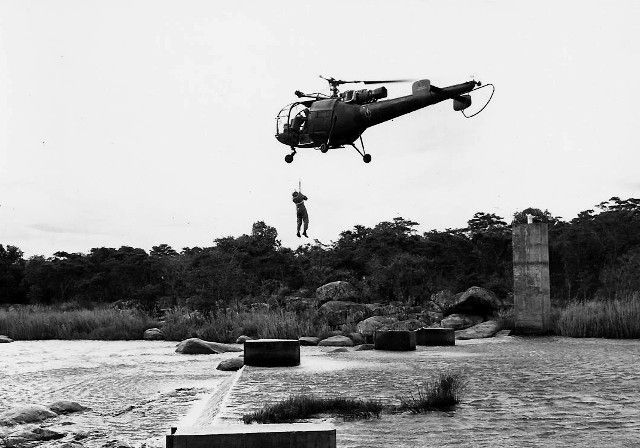

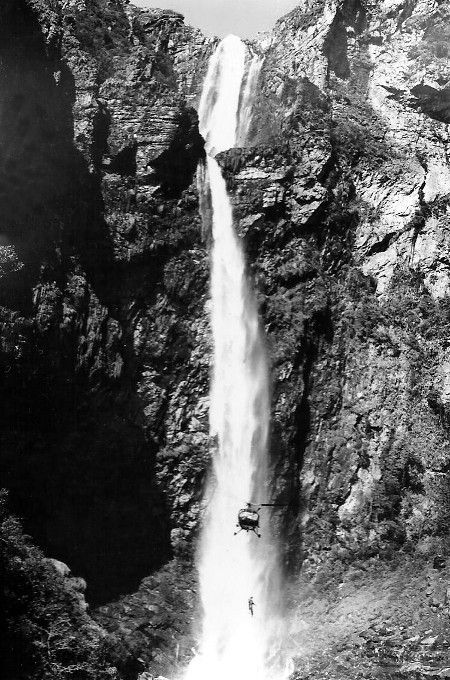
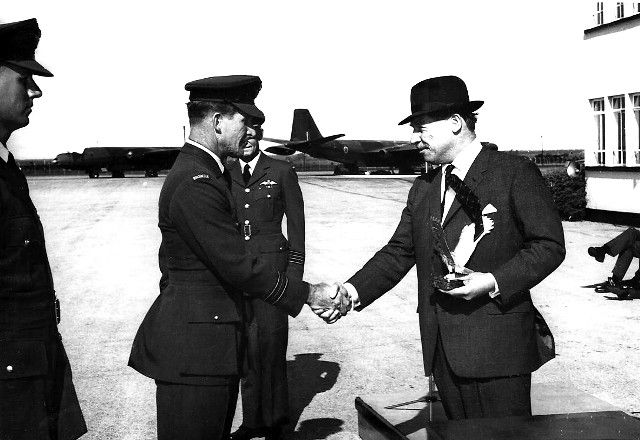
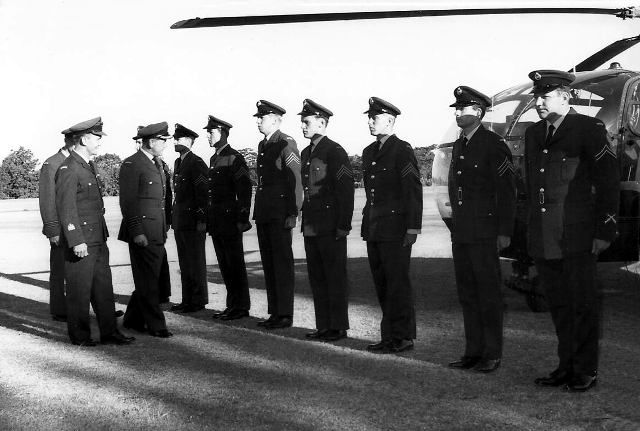
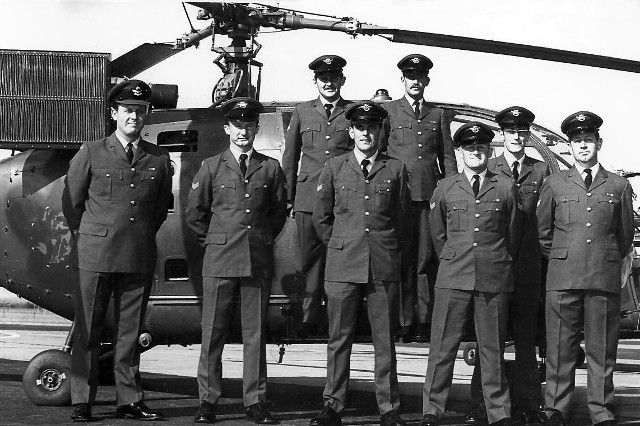
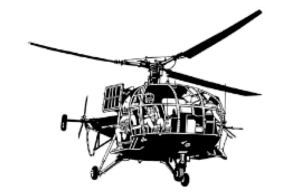


3 Comments:
Dear Sir or Madam,
I am an enthusiast for Steyr-Puch Haflinger vehicles and ther can be seen two of them in service with the Rhodesian Air Force on the second picture from the top of this page. I am trying to document the history of the Haflinger on my website, e.g. you can find an article about Haflingers in Rhodesia at http://tdc.haflinger-4wd.com/countries/rhodesia.php. I would love to use the picture from this website for my article. I would be glad to get in contact with you, my email address can be found on my website.
Thanks and with kind regards,
Constantin Kiesling
Amazing content thanks for sharing it with us.
Dictionary For PC
I recently came across your blog and found it very informative on modern safety practices. One perspective I would like to add is the increasing relevance of innovative fire fighting equipment in India. Among these, the fire fighting equipment has gained noticeable attention. Unlike traditional extinguishers, it is lightweight, requires no prior training, and activates automatically when it comes in contact with flames. This makes it an effective solution for homes, shops, offices, and warehouses where immediate human intervention may not be possible. Alongside, advanced fire fighting equipment such as automatic suppression tubes, high-quality fire cylinders, and smart alarm systems are further enhancing protection standards for businesses and individuals alike. In today’s time, where fire hazards can escalate within seconds, upgrading to these reliable solutions is no longer optional but essential. Thank you for highlighting such critical topics—your blog will surely inspire readers to adopt smarter fire safety measures.
Post a Comment
Subscribe to Post Comments [Atom]
<< Home